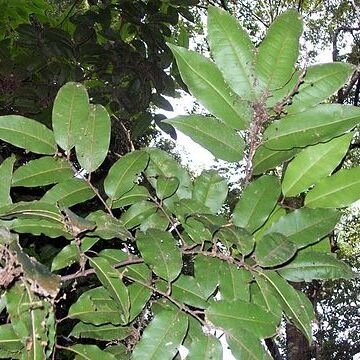Small tree, c. 6 m high; puberulous in infruc-tescences, glabrescent. Twigs 6-8 mm in diam. Leaves c. 3-jugate; petiole c. 17 cm long; petiolules c. 1 cm long. Leaflets elliptic, 12-16 by 4-5 cm, index c. 3, subcoriaceous; base acute; domatia very inconspicuous, in the axils of the nerves below; midrib above prominent, angular to locally rounded; nerves c. 15 per side, moderately curved; veins regularly reticulate, prominent on both surfaces. Inflorescences and flowers unknown. Infructescences ramiflorous, 13-16 cm long, branched. Calyx in fruit connate for ¼, lobes slightly unequal, triangular to ovate, c. 1.5 by 1 mm, outside glabrous, inside glabrous or with a few hairs, sub-coriaceous at the base, towards the top somewhat membranous with visible nerves, not accrescent. Petals: 1 was found together with 1 scar of a petal: elliptic, c. 0.75 by 0.5 mm, not clawed, without scales or auricles, glabrous. Disc in fruit annular, 1.5-2 mm in diam., slightly lobed, glabrous with lenticel-like dots. Fruits immature, green, probably all sterile, 8-10 mm high, glabrous; stipe 1-3 mm high, slightly lobed at the base, grading into the seed-bearing part; the latter about rounded-triangular in cross section, 5-7 mm in diam., inside pubescent on axial and suturai parts, sclerenchyma just, reaching into the septa. Seeds hardly developed (although fruit seemingly mature); arillode with a slightly lobed pseudo-funicle ± as long as the stalk.
Trees or shrubs, monoecious or dioecious. Leaves paripinnate, petiolate, estipulate; leaflets 1-5 pairs, with pellucid glands at lateral vein axils abaxially, entire. Thyrses axillary or fascicled near apex; bracts and bracteoles small. Flowers unisexual, actinomorphic. Calyx cupular, 5-lobed; sepals valvate. Petals 5 or sometimes only 1-3 imperfectly developed, rarely absent, scaly or hairy at base adaxially, rarely glabrous. Disk annular, sometimes lobed. Stamens (male flowers) 7-10, usually 8, exserted; filaments often hairy. Ovary (female flowers) shortly petiolate, obovoid, trigonous, 3(or 4)-loculed; ovules 1 per locule; style terminal, very short; stigmas 3, recurved. Capsules pear-shaped or clavate, ± trigonous, base or below middle part stalklike, loculicidal to 3 carpels, 1-3-loculed; pericarp leathery. Seeds 1 per locule; testa usually dark red, crustaceous, fully covered with fleshy and transparent arillode; embryo arched.
Monoecious trees. Indumentum of simple hairs. Leaves paripinnate; leaflets opposite to alternate, entire, coriaceous, usually prominently veined, densely reticulate; domatia usually present along midrib. Inflorescence in upper axils or ramiflorous, panicle-like; cymules usually stalked. Flowers small, regular. Calyx cupular, 5-dentate or-partite; lobes ovate, slightly imbricate. Petals 0–5, usually clawed, with 2 usually hairy crestless scales. Disc annular, often lobed. Stamens 7–9. Ovary stipitate, 3-locular; ovule 1 per locule; style persistent; stigma 3-lobed. Fruit usually on long stipe, apiculate; pericarp slightly fleshy, loculicidally 3-valved, 1-seeded; valves drying crustaceous or subwoody, usually shrivelled and inrolled after dehiscence. Seed ellipsoidal or globose, shiny; aril nearly covering seed, with slender appendage, thinly fleshy, ± translucent.

